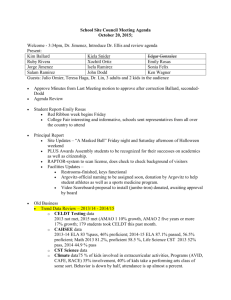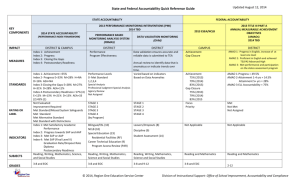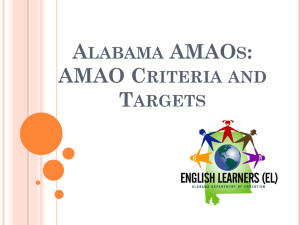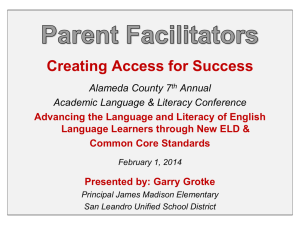GLOSSARY OF TERMS AND ACRONYMS
advertisement
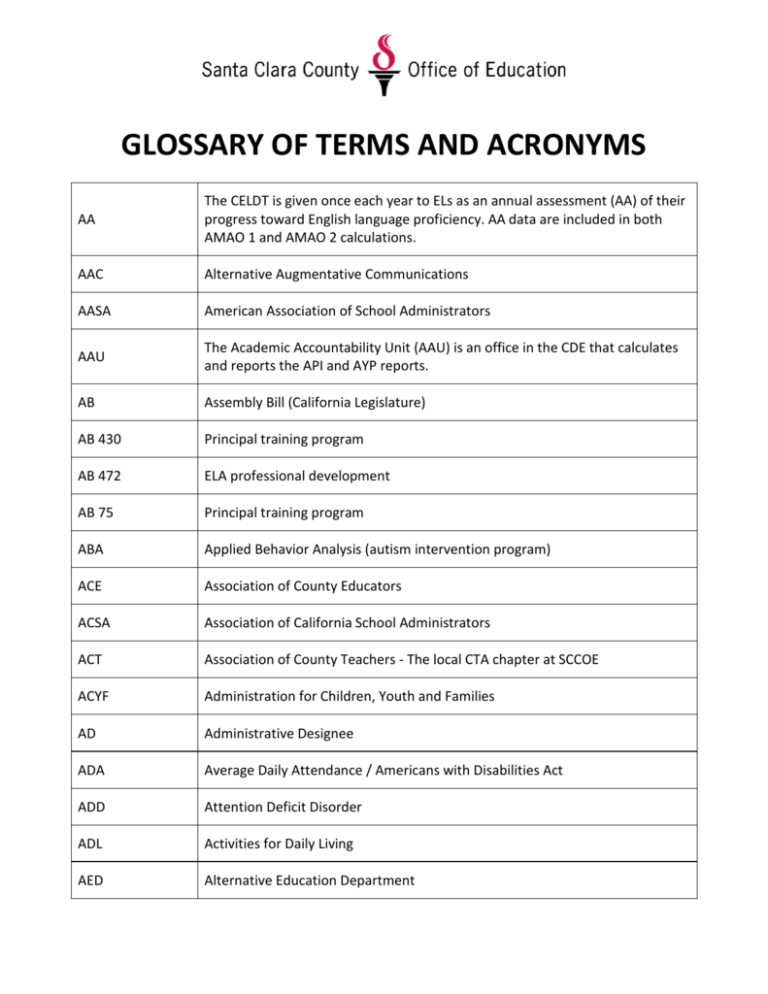
GLOSSARY OF TERMS AND ACRONYMS AA The CELDT is given once each year to ELs as an annual assessment (AA) of their progress toward English language proficiency. AA data are included in both AMAO 1 and AMAO 2 calculations. AAC Alternative Augmentative Communications AASA American Association of School Administrators AAU The Academic Accountability Unit (AAU) is an office in the CDE that calculates and reports the API and AYP reports. AB Assembly Bill (California Legislature) AB 430 Principal training program AB 472 ELA professional development AB 75 Principal training program ABA Applied Behavior Analysis (autism intervention program) ACE Association of County Educators ACSA Association of California School Administrators ACT Association of County Teachers - The local CTA chapter at SCCOE ACYF Administration for Children, Youth and Families AD Administrative Designee ADA Average Daily Attendance / Americans with Disabilities Act ADD Attention Deficit Disorder ADL Activities for Daily Living AED Alternative Education Department AESA Association of Educational Services Agencies – National association for county offices of education aka educational service agencies AMAO Title III of the ESEA sets Annual Measurable Achievement Objectives (AMAOs) or targets that school districts receiving Title III funds must meet. The first AMAO (AMAO 1) relates to making annual progress on the CELDT, the second (AMAO 2) relates to attaining English proficiency on the CELDT, and the third AMAO (AMAO 3) relates to meeting AYP by the English Learner student group at the LEA level. AMAOs 1 and 2 are based on CELDT results. AMAO 3 is based on data from the CST, CMA, CAPA, and/or the CAHSEE. AMARD The Analysis, Measurement, and Accountability Reporting Division (AMARD) of the CDE calculates and reports the API, AYP, PI, and Title III Accountability programs. AMOs Schools, LEAs, the state, and numerically significant student groups must meet percent proficient targets (or Annual Measurable Objectives [AMOs]) in ELA and mathematics on the assessments used in AYP calculations. AP Accounts Payable APA Alternative Placement Academy APE Adapted Physical Education API The Academic Performance Index (API) is the school accountability measurement under California’s PSAA of 1999. APR The Academic Progress Reporting (APR) system provides an integrated approach to reporting results for state and federal accountability requirements and includes API, AYP, PI, and Title III reports. ARAC Administrator Regional Advisory Council ARC Adolescent Residential Center ASAM Alternative Schools Accountability Model ASL American Sign Language AU Administrative Unit AVID Advancement via Individual Determination AWOL Away without leave (Absent without leave) AYP Adequate Yearly Progress (AYP) is the federal accountability measure with a series of annual academic performance targets established for LEAs and the state. Under AMAO 3 of Title III of the ESEA, LEAs are required to meet or exceed requirements within two areas of the EL student group in order to meet AYP annually: Participation Rate and Percent Proficient for Englishlanguage arts and mathematics. BCC Bilingual Certificate of Competency BCLAD Bilingual Cross-Culture Language Development BEAM Becas Educacionales a Migrantes BIP Basic Interview Pattern BOCES Board of Cooperative Educational Services BOE Board of Education BP Board Policy BSI-CAT Basic Skills Inventory – Computer Adaptive Testing BTSA Beginning Teachers Support and Assessment Program BTTP Bilingual Teachers Training Program BWC Bill Wilson Center CAASPP California Assessment of Student Performance Progress CAC Curriculum Advisory Committee CAHSEE The California High School Exit Examination (CAHSEE) is administered to all students in grade ten and to students in grades eleven and twelve if they did not pass the CAHSEE in grade ten. CAIS California Accountability & Improvement System (CAIS) is a web-based support system used to review school plans and monitor compliance documentation for schools (public and non-public), districts, and county offices that receive funding for certain programs. CALPADS California Longitudinal Pupil Achievement Data System (CALPADS) is a longitudinal data system used to maintain individual-level data including student demographics, course data, discipline, assessments, staff assignments, and other data for state and federal reporting. CalPERS California Public Employees’ Retirement System CALSTRS California State Teachers’ Retirement System CAMP College Assistance Migrant Program CAP California Assessment Program CAPA The California Alternate Performance Assessment (CAPA) is an alternate assessment for students with significant cognitive disabilities who cannot participate in the general STAR Program assessments, even with accommodations or modifications. CASAS Comprehensive Adult Student Assessment System CASBO California Association of School Business Officials – Organization of chief business/financial officers from the districts and county offices. CBEDS California Basic Education Data System C-BEST California Basic Education Skills Test CBL Character-Based Literature CBO Chief Business Officer CCBE California County Boards of Education - an organization made up of the 58 county boards of education. CCOC Central County Occupational Center CCR Coordinated Compliance Review CCSESA California County Superintendents Educational Services Association – statewide association the 58 county superintendents in California. CDD Child Development Division CDE The California Department of Education (CDE) is the state education agency for California. CDS Community Day School CDS Code County/District or School Code CEC Council for Exceptional Children CELDT The California English Language Development Test (CELDT) is the state test of English language proficiency that LEAs in California are required to administer to newly enrolled students whose primary home language is not English and to any student who is an EL as an AA (Education Code Section 313 and Title 5, California Code of Regulations, Section 11510). CELDT results are included in the calculations for AMAOs 1 and 2. CELDT Common Scale The CELDT was rescaled in 2006 to allow for the comparison of a student's scale score on each domain (listening, speaking, reading, and writing) going forward from 2006–07. A student's scale score on the new common scale can be compared to prior year's performance level and scale score to measure the annual growth of a student in learning English. CEP Center for Educational Planning CFR Code of Federal Regulations CFT California Federation of Teachers CH Communicatively Handicapped CHSPE California High School Proficiency Examination CIA Curriculum, Instruction, Assessment (No, it isn’t Central Intelligence Agency) CIHS Central Independence High School (Independent Study) CLAD Cross-Cultural Language and Academic Development CLAS California Learning Assessment System CMA The California Modified Assessment (CMA) is an alternate assessment of the California content standards based on modified achievement standards for students with an individualized education program who meet the State Board of Education adopted eligibility criteria. CNASDP Comprehensive Needs Assessment and Service Delivery Plan COE Certificate of Eligibility COE A county office of education (COE) administers educational programs and coordinates with schools and school districts at the county office level. COESTAR The online database that is used to track all MEP students in California COLA Cost of Living Adjustment Consortium To be eligible for a direct-funded LEP student subgrant, LEAs must be scheduled to receive a subgrant of $10,000 or more. If an LEA is projected to receive an LEP student subgrant of less than $10,000, the LEA must enter into an agreement to form and/or join a consortium in which the total amount of the subgrants of members of the consortium collectively total $10,000 or more. In the case of a consortium of LEAs, only the lead LEA is the grantee. (Title III, Section 3114). The accountability data for the consortium lead and the consortium members are aggregated up to the consortium level to determine if the AMAOs have been met for the consortium as a whole. CP Cerebral Palsy CPIN California Preschool Instructional Network CPM Categorical Program Monitoring CPS Children’s Protective Services; Dept. of Social Services CSBA California School Boards Association - made up of the 1,000+ school district and county boards in the state. CSEA CA School Employees Association CSIS California Student Information System CSSA California Safe Schools Act CST The California Standards Test (CST) is a set of tests annually administered to students in grades two through twelve. It includes the content areas of Englishlanguage arts, mathematics, history-social science, and science. CSU California State University CTA California Teachers Association – statewide teachers union. CTAP California Technology Assistance Project CTC California Teacher Credential CTE Plan California Career Technical Education State Plan CTEL or C-TEL California Teacher of English Learners CYO California Youth Outreach D&A Drug & Alcohol D/HOH Deaf/Hard of Hearing DAC District Advisory Committee DBAS District Business Advisory Services DD Developmental Disabilities DELAC District English Learner Advisory Committee DFCS Department of Family and Children’s Services DHS California Department of Health Services and Digital High School DIS Designated Instructional Services. DOE Department of Education (Federal) DOL Department of Labor Domains The CELDT assesses four domains in kindergarten through grade twelve: listening, speaking, reading, and writing. DRM The Data Review Module (DRM) is an online data correction application for the CELDT used to correct demographic and testing data for students whose answer books were submitted by the AA window deadlines. DSA District Service Agreement DSA Division of State Architecture DSLT District School Leadership Team EAP Employee Assistance Program EC California Education Code ECE Early Childhood Education ED Emotional Disturbance ED The United States Department of Education EDC Educational Development Center EDGAR Education Department General Administrative Regulations EdTech Educational Technology EduSoft EduSoft Software (Assessment Management System) EEOC Equal Employment Opportunity Commission EETT Enhancing Educational Through Technology EITEL Effective Instruction for Teachers of English Learners EJWC Education of Juvenile Court Wards EL An English Learner is a student with a primary language other than English who is not yet proficient in English. ELA English-Language Arts is a content area of STAR Program tests. ELAC English Learner Advisory Committee ELAC English Language Acquisition Consortium ELD English Language Development ELD Standards The English Language Development (ELD) standards, adopted by the State Board of Education in 1999, define what English learners in California public schools must know and be able to do as they progress toward full fluency in English. ELL English Language Learner ELSSA English Learner Subgroup Self Assessment EMC Educational Media Center EMS Emergency Medical System English Proficient Level The criterion for English language proficiency is an overall score of Early Advanced or higher and a score of Intermediate or higher for each domain (listening, speaking, reading, and writing). For Kindergarten and grade one, the criterion for English language proficiency is an overall score of Early Advanced or higher and a score of Intermediate or higher for the domains of listening and speaking. EO English Only EOE End of Eligibility EPGY Education Program for Gifted Youth EPS Emergency Protective Services ERA The Evaluation, Research, and Analysis (ERA) unit is an office in the CDE that calculates and reports the PI and Title III Accountability reports. E-RATE Discounted Telecommunications Services for Schools & Libraries ESCORT Eastern Stream Center on Resources and Training ESEA Elementary and Secondary Education Act ESEA Title III of the Elementary and Secondary Education Act (ESEA) requires states to administer a test to newly enrolled students whose primary (home) language is not English to determine their level of English language fluency. In California, the CELDT serves this purpose. Students identified through the initial assessment as English learners must be given the CELDT annually until they are reclassified as fluent English proficient. Title III sets AMAO targets that school district receiving Title III funds must meet. ESL English as a Second Language ESOL English for Speakers of Other Languages ESP Early Start Program (birth to three) ETC Educational Technology Consortium EVC East Valley Clinic FCMAT Fiscal Crisis and Management Team FEP Fluent English Proficiency FERPA Family Educational Rights and Privacy Act FLY Fresh Lifelines for Youth FPM / CPM Federal/Compliance Program Monitoring FRL Free & Reduced Lunch FTE Full Time Equivalency (related to employee hours) FY Fiscal Year FYI For Your Information FYS Foster Youth Services GATE Gifted and Talented Education GED General Education Development GEPA General Education Provisions Act GI Gang Intervention GPRA Government Performance Results Act HCYEP Homeless Child and Youth Education Program HEA Higher Education Act HEP High School Equivalency Program HEP Homeless Education Program HHS U.S. Department of Health and Human Services HOH Harvest of Hope Foundation HOH/DEAF Hard of Hearing/Deaf HR Human Resources HS High School HSEE High School Exit Exam I&R Identification and Recruitment IA The CELDT is first given to newly enrolled students, whose primary language is not English, as an initial assessment (IA) of English language fluency. AMAO 2 calculations include initial CELDT takers tested during the AA window if they are classified as EL. IASA Improving America's Schools Act (1994) ICSM Individual Critical Skills Model IDEA (97) Individual with Disabilities Education Act IEL Institute for Educational Leadership IEP Individualized Education Plan IFEP Initial Fluent English Proficient (IFEP) students are students with a primary language other than English who took the CELDT within 30 days of enrollment in a U.S. public school and who met the school district criterion for English language proficiency (i.e., those students who were initially identified as fluent in English). IFEP students are not included in AMAO calculations. IFSP Individualized Family Service Plan IHE Institution of Higher Education ILP Individualized Learning Plan IMEC Interstate Migrant Education Council INA Initial Needs Assessment INEA Instituto Nacional de Educación para Adultos INS Immigration and Naturalization Services IPP Individualized Program Plan IS Independent Study IT Information Technology ITFS Instructional Television Fixed Service ITP Individualized Transition Plan ITV Instructional Television IWEN Individual With Exceptional Needs JCCASAC Juvenile Court, Community and Alternative School Administrators of California JJC Juvenile Justice Commission JPA Joint Powers Agreement JPD Juvenile Probation Division JTPA Job Training Partnership Act K-12 Kindergarten through 12th Grade LAS-O Language Assessment Scale-Oral LCAP Local Control Accountability Plan LCCE Life Centered Career Education LCFF Local Control Funding Formula LCI Licensed Children’s Institution LD Learning Disabled LEA A Local Educational Agency (LEA) is a government agency which supervises local public primary and secondary schools in the delivery of instructional and educational services. For Title III Accountability, LEAs include school districts, county offices of education, direct-funded charter schools, and consortium leads. LEAP LEA Plan – A requirement for LEAs receiving certain federal funds. LEP The Title III limited-English proficient (LEP) student program is provided for LEP students, referred to as ELs in California, to help them attain English proficiency, develop high levels of academic attainment in English, and meet the same challenging state academic standards as all other students. LOU Letter of Understanding LRE Least Restrictive Environment LST Learning Support Team LT Leadership Team LTEL Long Term English Learners LTM Long Term Memory MC or M/C Mail Code MCS Management, Confidential and Supervisory Employees MD Muscular Dystrophy or Medical Doctor MDT Multi-Disciplinary Team MEES Migrant Education Even Start MEP Migrant Education Program MESN Migrant Education Student Network (Region 1 Website) MF Medically Fragile MFCC Marriage-Family-Child Counselor MGPTF Mayor's Gang Prevention Task Force MH Multi-handicapped / Mental Health MIIEO Migrant, Indian, and International Education Office MIS Management Information System MLAP Migrant Learner Action Plan MLE Meditated Learning Experience MOU Memorandum of Understanding MS Middle School / Multiple Sclerosis/ Mail Stop MSFW Migrant and/or Seasonal Farm worker MSIN Migrant Student Information Network (WestEd Website) MSIS Migrant Student Information System (California) MSIX Migrant Student Records Exchange Initiative (Federal Website) MSPA Migrant and Seasonal Agricultural Workers Protection Act NA (N/A) Not Applicable / Not Available NAME National Association of Migrant Education NASDME National Association of State Directors of Migrant Education NCES National Center for Education Statistics NCLB No Child Left Behind (2001) NEP National Equity Program NEP Non-English Proficiency NISE NISE Reporter – Salary & Benefit Management NLCI Non Licensed Care Institution NPS Non-Public School NSBA National School Boards Association O/M Orientation / Mobility O/T Operations / Technology / Occupation Therapy OBEMLA Office of Bilingual Education and Minority Languages Affairs OCR Office of Civil Rights OESE Office of Elementary and Secondary Education OHI Other Health Impaired OI Orthopedically Impaired; formerly OIG Office of the Inspector General OMB Office of Management and Budget OME Office of Migrant Education (Federal) OPSC Office of Public School Construction (State Office) OSS Operations Support Services OST Office Support Team OSY Out of School Youth OT Occupational Therapy, Out Temporarily OTBS Office, Technical and Business Services PAC Parent Advisory Council PAR Peer Assistance & Review Program PARS Parent Authorization and Recruiters Statement PASS Portable Assisted Study Sequence PBIS Positive Behavior Interventions and Support PD Professional Development PD Program Development PDS Professional Development Services PERS Public Employees Retirement System PFS Priority for Service PH Physically Handicapped PHN Public Health Nurse PI LEAs and consortia that have failed to meet Title III Annual Measurable Achievement Objectives (AMAOs) for two consecutive years are in program improvement (PI) status and are required to develop an Improvement Plan that will ensure the LEA or consortia will meet AMAOs in the future. PIC Private Industry Council PIC Parent Involvement Committee PLC Professional Learning Community PO Probation Officer / Purchase Order PPS Pupil Personnel Services PR Public Relations / Purchase Request or Requsition PSAA The Public Schools Accountability Act (PSAA) of 1999 established the API, the state accountability requirements for California. PSQR Program Standard Quality Review PSWA Psychologist and Social Workers Association PT Physical Therapy / Part Time PTA Parent Teacher Association PY Program Year QAD Qualifying Arrival Date QC Quality Control QCC SCCOE Software for Business, H.R. & Payroll QI Quality Improvement QIT Quality Improvement Training QSS Older version of QCC RAC Regional Parent Advisory Council RFEP Reclassified Fluent English Proficient (RFEP) students are students with a primary language other than English who were initially classified as English learners, but who have subsequently met the school district criteria for English language proficiency are determined to be fluent English Proficient. RFEP students are not included in AMAO calculations. RFP Request for Proposal RIF Reduction in Force ROP Regional Occupational Program RSP Resource Specialist Program RTC Regional Technology Center RTI Response to Instruction and Intervention SACS Standardized Account Code Structure SAIT School Assistance Improvement Team SAPS Student Action Plan for Success SARB School Accountability Review Board SARC School Accountability Review Card SARC School Accountability Report Card SB Senate Bill (California Legislature) SB 472 ELA or Math Professional Development SBE State Board of Education SCAN School-Centered Assessment of Needs SCC Santa Clara County SCCOE Santa Clara County Office of Education SCCSBA Santa Clara County School Boards Association SCFLC Santa Clara Family Living Center SCU Santa Clara University SD Staff Development / Sheriff’s Department SDAIE Specially Designed Academic Instruction in English SDC Special Day Class SDE State Department of Education SE Student's Edition of a Book SEA State Education Agency SEEDS Software Educational and Evaluation Demo Site SEIU Service Employees International Union - Local 521 represents employees who are neither teachers nor managers, such as instructional aides, custodians, administrative assistants, clerks, etc. SELPA Special Education Local Plan Area SEP Secretaria de Educación Publica (México) SES Supplemental Education Services OR Socio-Economic Status SGC Supervisor of Group Counselors SH Severely Handicapped SIM Strategies Intervention Model SIP Site Improvement Plan SJFS San Jose Family Shelter SJPD San Jose Police Department SMART Specific, Measurable, Action-Orientated/Attainable, Realistic/Results Oriented, Time-limited (bound) SOC School Office Coordinator SOLAR System Students On Line Administrative Resource System SOLOM Student Oral Language Observation Matrix SPAC State Parent Advisory Council SPED Special Education SS Support Services SSA Support Service Assistance SSB Student Services Branch SSC School Site Council SSID Statewide Student Identifiers SSPQ Student Survey on Program Quality SSR Sustained Silent Reading SST Student Study Team STAR Program Each spring, students in grades two through eleven take a STAR test. Students take tests in math, reading, writing, science, and history. The STAR Program includes four tests: the California Standards Tests, the California Modified Assessment, the California Alternate Performance Assessment, and the Standards-based Tests in Spanish. STAR-R STAR-Renaissance STM Short Term Memory STRS State Teachers’ Retirement System SVEF Silicon Valley Educational Foundation SW Social Worker TACAC Teacher and Classified Advisory Committee TANF Temporary Assistance for Needy Families TAPP TeenAge Parent Program TBA To Be Announced / To Be Arranged TBD To Be Determined TE Teacher's Edition of a Book TIC Teacher-in-Charge TORC Test of Reading Comprehension TOSA Teacher on Special Assignment TQM Total Quality Manager TRC Teachers Resource Center TSA Tax Sheltered Annuity TUPE Tobacco-Use and Prevention Education UC University of California USDA United States Department of Agriculture USDE United States Department of Education UTL Unable to Locate VI Visually Impaired VMC Valley Medical Center VPSS Verification Process for Special Settings WASC Western Association of Schools and Colleges WEE Work Experience Education WIA Workforce Investment Act (Formerly JTPA) WIC Women, Infants and Children WRAT Wide Range Achievement Test YEA Youth Education Advocates YTD Year to Date
